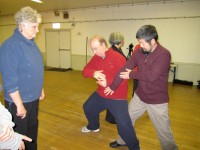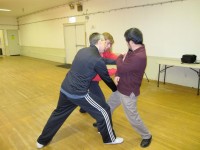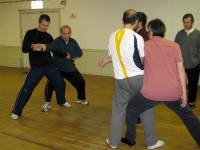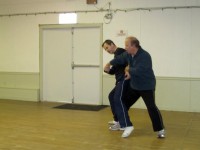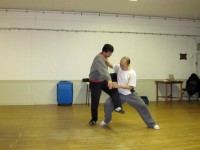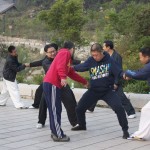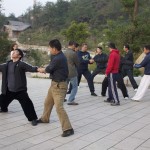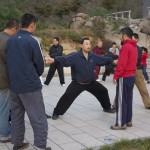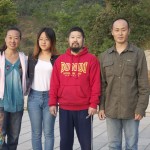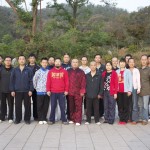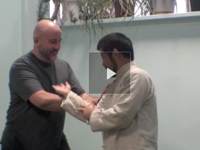 When doing the bare-hand form and pushing hands with an opponent, one must keep the power constant. This is one of the characteristics of Chen Style Taijiquan Practical Method. By keeping to this principle, one will gradually gain more internal abilities.
When doing the bare-hand form and pushing hands with an opponent, one must keep the power constant. This is one of the characteristics of Chen Style Taijiquan Practical Method. By keeping to this principle, one will gradually gain more internal abilities.
Knowledge : Principle-Technical
Master Chen went over in detail exercises for establishing an axis in push hand and in Yilu. The second requirement is to keep the axis not moving, only then rotation can happen. The arm moves because of axis rotation, opponent will feel power but there is no power on the arm. Photos by Jay Smith.
We are happy to have Carmen Farruggia of Sacremento, CA, USA join us again for this workshop.
In Practical Method, when we want to move foot forward, back, or side, we need to have the weight shift to the supporting leg and “pump” the other leg out. In other words, the leg which is moving out will not interfere the whole body balance. It’s independent from the rest of the body. It can move freely. The taiji terminology for this is “Chan Chu” (Shovel out). Read more
 No problem, I really appreciate the opportunity to participate in these discussions. It helps to solidify my understanding of things as I study videos and practice. One of the videos that helped clarify one of the main contradictions/sources of confusion is the mini lesson “Hands on Positive Circle Sequence” where Master Chen is detailing the 9 count circle for you, Michael, and a small group of students on the mountain. Read more
No problem, I really appreciate the opportunity to participate in these discussions. It helps to solidify my understanding of things as I study videos and practice. One of the videos that helped clarify one of the main contradictions/sources of confusion is the mini lesson “Hands on Positive Circle Sequence” where Master Chen is detailing the 9 count circle for you, Michael, and a small group of students on the mountain. Read more
Master Chen taught the two main taiji energies: push and pull. Every push must be a pull. Showed and did an exercise on how to turn the body into a rotation spool to create power.
架子
“架子”是“拳架”一词的更口语,更随意的说法。练太极的都把“架子”挂在嘴边上。练套路叫“走架”,叫“盘架子”。师傅对生徒练的套路里的错误加以纠正,以及为提高生的套路水平而加以指点,都叫“拨架子”,因为“拨”字,含有“拨正”和“点拨”的意思。 Read more

Demonstration, instruction and drills about the pulling energy of taijiquan. This is part of the Jan. 2012 Toronto workshop on Chen Style Taijiquan Practical Method. Related explanations about shoulder, elbow, kua, alignment, vertical axis are given in light of the pulling energy. Presenter: Chen Zhonghua Length: 39 min. In: English Year: 2011 Difficulty:2/5 At:Toronto, Canada
在国内,打太极拳的随处可见;在国外也不罕见。如果您稍微留点儿心,就会发现,绝大多数人走架的时候,手的动作多、动作大而且繁复。推手时也如是,净看见两个人用手互相推拉撕扯了。 Read more
In the last few months, I have been trying to follow the rule of “elbow in, hand out”. In my practice and teaching I have observed something that needs further verification, but that seems correct. “Elbow in” means: initiate the arm rotation from the upper arm. Conversely, “hand out” means: initiate the arm rotation from the hand. There are a few possible explanations for this. First, I will say a few words about the “elbow in” part of rule, then I will suggest an explanation of the “hand out” part of the rule. Read more
 When the body becomes accustomed to moving through the forms in a connected way, the structure of the body will naturally begin to tighten up. As a result, the over exaggerated stretching movements previously used to open up and recondition the body should be adjusted and made smaller and tighter. Read more
When the body becomes accustomed to moving through the forms in a connected way, the structure of the body will naturally begin to tighten up. As a result, the over exaggerated stretching movements previously used to open up and recondition the body should be adjusted and made smaller and tighter. Read more
Sometimes you move, sometimes you don’t. Some parts of the body should move while other parts must be tranquil. The correct application of these is taiji. Read more
Body movement principle is that the upper and lower parts of the body must not be synchronized. When the upper body moves, the lower body must not move. When the left side of the body moves, the right side of the body cannot move. When the hands move, the waist cannot move.
1. “To occupy strategic position you must fight for the meridian”. Read more
When issuing power, the shoulder must stay stable, not popping up or moving, in order to transmit power from hand to foot, or vice versa.
The hand is the most used part of the body. It is also the focus of taijiquan activities. This video clips shows how the power of the entire body can be focused onto the hands and even fingers to fight again an opponent.

Nothing is as good as personal instruction. This is close to it.
Presenter: Chen Zhonghua Length: 76 min. In: English Year: 2011 Difficulty:2/5 At:Germany
 Eventually, higher level students of Taijiquan come realize that the power produced in practice should never be produced by the muscles. But if it isn’t produced in the muscles, where does the incredible strength, flexibility and speed of the great masters come from? I believe this question can be answered by understanding the amazing system of tendons and ligaments which connects the muscular and skeletal structures. Although many people like to believe that “qi”
Eventually, higher level students of Taijiquan come realize that the power produced in practice should never be produced by the muscles. But if it isn’t produced in the muscles, where does the incredible strength, flexibility and speed of the great masters come from? I believe this question can be answered by understanding the amazing system of tendons and ligaments which connects the muscular and skeletal structures. Although many people like to believe that “qi”
When you fix your eyes on the target, you can truly rotate your body. Otherwise, you are just tossing!
There must be a proportional dispensation of movement, or in other words, one body part should not be outdoing the others.
 It seems to me that most people are not aware of the spiraling that should occur throughout the body while doing Taijiquan. Even though most people must have seen the ancient diagrams of a body coiled in lines representing the spiraling paths of the silk reeling energy (chansijin) characteristic of Chen style Taijiquan, very few people seem to be able to explain or even understand what this principle actually is. Obviously, it is not only important to know how to create spiraling throughout the body, but also to understand why spiraling and the unique energy it creates is so important to the art.
It seems to me that most people are not aware of the spiraling that should occur throughout the body while doing Taijiquan. Even though most people must have seen the ancient diagrams of a body coiled in lines representing the spiraling paths of the silk reeling energy (chansijin) characteristic of Chen style Taijiquan, very few people seem to be able to explain or even understand what this principle actually is. Obviously, it is not only important to know how to create spiraling throughout the body, but also to understand why spiraling and the unique energy it creates is so important to the art.
“To withdraw is to issue” is a taiji concept. To train the body to utilize levers is a method to incorporate this concept into taiji practice. In Chen Style Taijiquan Practical Method system, Hong Junsheng’s aphorism “Hand out elbow in” (In with elbow without the hand; out with hand without the elbow) is the realization of this concept on the upper body; while “Sink down to grind out” is the realization of the same concept on the lower body.
This is one of Grandmaster Hong Junsheng’s favorite sayings. It is a technical principle of his Chen Style Taijiquan Practical Method system. By following this principle, many other important theoretical principles will start to manifest themselves eventually. This is the foundation of foundations in this system.
Proper sequence for stepping in Yilu and push hand. Step need to be broken into three moves in order to have separation power.
The direction of the knees is one is up and the other is down. This does not mean that knee moves up and down. It means the energy of the knees must move vertically in order to have root on the foot. Moving the knees up and down is a flaw.
-
- The elbow and waist (from one side of the waist to the other side) must have a Read more
- The hand and foot must have a connection through the waist, or dantiian area. In this case the waist becomes the modifier. Read more

